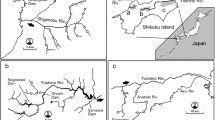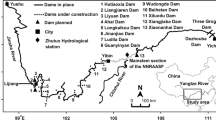Abstract
Huge dams (installed capacity > 100 MKW) are generally built on large rivers that display high biodiversity and include major migration routes for many diadromous and potamodromous fish. As a result, these dams lead to severe ecological impacts and receive more attention than smaller dams. Most previous work on the impact of huge dams on fish downstream movement has focused on a single dam and reservoir, so little is known about the effect of cascaded huge dams and reservoirs on downstream movement. During the period 2012–2014, two huge dams (the Xiangjiaba and the Xiluodu) were constructed on the upper Yangtze River and the reservoir impoundments began, respectively in October 2012 and May 2013. These cascaded hydroelectric projects could have a large adverse effect on the downstream movement of an important potamodromous fish species, Coreius guichenoti. To study the effect of cascaded impact of sequential huge dams and reservoirs on passive and active downstream movement of C. guichenoti, eggs and larvae were collected in the Yibin section during 2012–2014 and fish were collected monthly at a site in the Hejiang section from June 2012 to July 2014. Our results showed that, compared to one huge reservoir and dam, cascaded dams exert a more serious effect and obstruct downstream movement of eggs, larvae and young fish (particularly the yearlings and two-year-olds) of C. guichenoti. Individual C. guichenoti were able to pass with relative ease through one reservoir and dam, but passing through both reservoirs and dams was very difficult. To allow access to the spawning grounds upstream, a fish passage should be built on the Xiluodu dam. However, due to the hydropower development in the whole upper basin, captive breeding and maintaining at least 60 km of riverine habitat upstream of a spawning ground could be a more cost-effective approach to maintaining C. guichenoti populations in the Upper Yangtze River.




Similar content being viewed by others
References
Armstrong JD, Kemp PS, Kennedy GJA, Ladle M, Milner NJ (2003) Habitat requirements of atlantic salmon and brown trout in rivers and streams. Fish Res 2:143–170
Baxter RM (1977) Environment effects of dams and impoundments. Annu Rev Ecol Syst 8:255–283
Buysse D, Mouton AM, Stevens M, Neucker TVD, Coeck J (2013) Mortality of European eel after downstream migration through two types of pumping stations. Fish Manag Ecol 1:13–21
Clarke KR, Gorley RN (2006) PRIMER v6: user manual/tutorial. Plymouth routines in multivariate ecological research. PRIMER-E Ltd, Plymouth
Cheng F, Li W, Castello L, Murphy BR, Xie S (2015) Potential effects of dam cascade on fish: lessons from the Yangtze River. Rev Fish Biol Fish 3:1–17
Ding RH (1994) The fishes of Sichuan Sichuan Publishing House of Science and Technology, Chengdu 76–278
Duan XB, Tian HW, Gao TH, Liu SP, Wang K, Cheng DQ (2015) Resources status of ichthyoplankton in the upper Yangtze River before the storage of Jinsha River first stage project. Resour Environ Yangtze Basin 8:1358–1365
Dulčić J, Pallaoro A, Matić-Skoko S, Dragičević B, Tutman P, Grgičević R, Stagličić N, Bukvić V, Pavličević J, Glamuzina B, Kraljević M (2011) Age, growth and mortality of common two-banded seabream, Diplodus vulgaris (Geoffroy Saint-Hilaire, 1817), in the eastern Adriatic Sea (Croatian coast) J Appl Ichthyol 27: 1254–1258
Fan XG, Wei QW, Chang JB, Rosenthal H, He JX, Chen DQ, Shen L, Du H, Yang DG (2006) A review on conservation issues in the upper Yangtze River- a last chance for a big challenge: can Chinese paddlefish (Psephurus gladius), Dabry’s sturgeon (Acipenser dabryanus) and other fish species still be saved? J Appl Ichthyol 22(S1):32–39
Fontes Júnior HM, Castro-Santos T, Makrakis S, Gomes LC, Latini JD (2012) A barrier to upstream migration in the fish passage of Itaipu dam (canal da piracema). Paraná river basin Neotrop Ichthyol 4:697–704
Gao SB, Tang HY, Chen S, Yang Z, Dong FY (2015) Effect of the first phase of Jinsha hydropower project on fish recruitment: early life history stages of Coreius guichenoti in the upper Yangtze River. J Hydroecol 2:6–10
Hahn L, Karl E, Carosfeld J, da Silva LGM, Latini JD, Agostinho AA, Fernandez DR (2007) Preliminary study on the application of radio-telemetry techniques to evaluate movements of fish in the lateral canal at Itaipu dam, Brazil. Neotrop Ichthyol 2:103–108
Heggenes J, Traaen T (2006) Downstream migration and critical water velocities for fry of four salmonid species. J Fish Biol 5:717–727
Henderson PA, Bird DJ (2010) Fish and macro-crustacean communities and their dynamics in the Severn estuary. Mar Pollut Bull 1:100–114
Hoagstrom CW, Turner TF (2015) Recruitment ecology of pelagic-broadcast spawning minnows: paradigms from the ocean advance science and conservation of an imperilled freshwater Fauna. Fish Fish 2:282–299
Jung S (2014) Asynchronous responses of fish assemblages to climate-driven ocean regime shifts between the upper and deep layer in the Ulleung basin of the East Sea from 1986 to 2010. Ocean Sci J 1:1–10
Kapuscinski KL, Farrell JM (2014) Habitat factors influencing fish assemblages at muskellunge nursery sites. J Great Lakes Res 1:135–147
Katano O, Nakamura T, Abe S, Yamamoto S, Baba Y (2006) Comparison of fish communities between above- and below-dam sections of small streams; barrier effect to diadromous fishes. J Fish Biol 3:767–782
Liu LH, Wu GX, Wang ZL (1990) Reproduction ecology of coreius heterodon (Bleeker) and coreius guichenoti (Sauvage et Dabry) in the mainstream of the Changjiang River after the construction of gezhouba dam Acta. Hydrobiol Sin 3:205–215
Matthews WJ, Marsh-Matthews E (2007) Extirpation of red shiner in direct tributaries of Lake Texoma (Oklahoma–Texas): a cautionary case history from a fragmented river–reservoir system. Trans Am Fish Soc 136:1041–1062
Morita K, Morita SH, Yamamoto S (2009) Effects of habitat fragmentation by damming on salmonid fishes: lessons from white-spotted charr in Japan. Ecol Res 4:711–722
Mu HX (2014) Study on fish early resources at the end of three gorges reservoir and below the three gorges dam. University of Chinese Academy of Sciences, Beijing
Nehlsen W, Williams JE, Lichatowich JA (1991) Pacific salmon at the crossroads: stocks at risk from California, Oregon, Idaho, and Washington. Fisheries 2:4–21
Oliva-Paterna FJ, Torralva MM, Fernandez-Delgado C (2002) Age, growth and reproduction of Cobitis paludica in a seasonal stream. J Fish Biol 60:389–404
Park YS, Chang JB, Lek S, Cao WX, Brosse S (2003) Conservation strategies for endemic fish species threatened by the three gorges dam. Conserv Biol 6:1748–1758
Pess GR, Mchenry ML, Beechie TJ, Davies J (2016) Biological impacts of the Elwha river dams and potential salmonid responses to dam removal northwest. Sci Spec 1:72–90
Pelicice FM, Agostinho CS (2012) Deficient downstream passage through fish ladders: the case of Peixe Angical dam, Tocantins River, Brazi. Neotrop Ichthyol 4:705–713
Pelicice FM, Pompeu PS, Agostinho AA (2015) Large reservoirs as ecological barriers to downstream movements of Neotropical migratory fish. Fish Fish 16:697–715
Skalski JR, Townsend R, Lady J, Giorgi AE, Stevenson JR, Mcdonald RD (2002) Estimating route-specific passage and survival probabilities at a hydroelectric project from smolt radiotelemetry studies. Can J Fish Aquati Sci 59:1385–1393
Sheer MB, Steel EA (2006) Lost watersheds: barriers, aquatic habitat connectivity, and salmon persistence in the Willamette and lower Columbia river basins. Trans Am Fish Soc 6:1654–1669
Sommer TR, Nobriga ML, Harrell WC, Batham W, Kimmerer WJ (2001) Floodplain rearing of juvenile chinook salmon: evidence of enhanced growth and survival. Can J Fish Aquat Sci 2:325–333
Tao J, Yong G, Ye Q, Zheng H, Xiang W, Li W, Chang JB (2010) Hydroacoustic observation of fish spatial patterns and behavior in the ship lock and adjacent areas of Gezhouba dam, Yangtze River. Acta Ecol Sin 30(4):233–239
Tabor RA, Brown GS, Luiting VT (2011) The effect of light intensity on sockeye salmon fry migratory behavior and predation by cottids in the Cedar River, Washington. N Am J Fish Manag 1:128–145
Tang XL, Chen DQ, Wang K, Liu SP, Luo HW, Duan XB (2010) Spatial and temporal distribution of larval resources of fishes in the upper reaches of Yangtze River. Freshw Fish 5:27–31
Vehanen T, Huusko A, Maki-Petäys A, Louhi P, Mykär H, Muotka T (2010) Effects of habitat rehabilitation on brown trout (Salmo trutta) in boreal forest streams. Freshw Biol 55:2200–2214
Wan A, Yu SJ, Hu J, Wan Y, Wei Y, Zhong M, Yang HF, An SQ, Yan YZ (2015) The age, growth, fecundity of Carassius auratus in the Guohe River of Guoyang County. CSAWAC 5:621–786
Watene EM, Boubée JAT (2005) Selective opening of hydroelectric dam spillway gates for downstream migrant eels in New Zealand. Fish Manag Ecol 12:69–75
Walters DM, Zuellig RE, Crockett HJ, Bruce JF, Lukacs PM, Fitzpatrick RM (2013) Barriers impede upstream spawning migration of flathead chub. Trans Am Fish Soc 1:17–25
Wu SY, Shen MB (2007) The key technical issue and its research advance in Yalong River hydropower development. Shuili Xuebao S1:20–24 (in Chinese)
Xu W, Qiao Y, Chen XJ, Cai YP, Yang Z, Liu HG (2015) Spawning activity of the four major Chinese carps in the middle mainstream of the Yangtze River, during the three gorges reservoir operation period. China J Appl Ichthyol 31:846–854
Yang S R, Ma BS, Kong Y, Zhou C, Liu HZ (2010) Growth features of juvenile coreius guichenoti and its conservation in the three gorges reservoir. Resour Environ Yangtze Basin (Supp 2):52–57 (in Chinese)
Yang SR, Gao X, Li M, Liu HZ (2012) Interannual variations of the fish assemblage in the transitional zones of the three gorges reservoir: persistence and stability. Environ Biol Fish 93:295–304
Yang Z, Tang HY, Zhu D, Liu HG, Wan L, Tao JP, Qiao Y, Chang JB (2015) Spatiotemporal patterns of fish community structures in the three gorges reservoir and its upstream during the 175-m-deep impoundment. Acta Ecol Sin 15:5064–5075
Yu ZT, Liang ZS, Yi BN (1984) The early development of Coreius heterodon and Coreius guichenoti. Act Hydrobiol Sin 4:371–388
Zhang YC (2009) Impact of dam on natural reproduction of Coreius guichenoti and Rhinogobio ventralis in upstream of Yangtze River. University of Chinese Academy of Sciences, Beijing
Acknowledgements
We sincerely thank Yun Gong, Qiong Xiao and Pengxiang Duan for their help on the sample treatment in the laboratory. We also sincerely thank David Mark Johnson for helping to modify the English language. This work was supported by the National Natural Science Foundation of China (Grant No. 51379134 and 51309168) and the Ecological and Environmental Monitoring Programs of China Three Gorges Project Corporation (Grant No. 0799527).
Author information
Authors and Affiliations
Corresponding author
Ethics declarations
This study complies with the Chinese law. All the living fishes were released into their natural environment after sampling.
Rights and permissions
About this article
Cite this article
Yang, Z., Tang, H., Tao, J. et al. The effect of cascaded huge dams on the downstream movement of Coreius guichenoti (Sauvage & Dabry de Thiersant, 1874) in the upper Yangtze River. Environ Biol Fish 100, 1507–1516 (2017). https://doi.org/10.1007/s10641-017-0661-7
Received:
Accepted:
Published:
Issue Date:
DOI: https://doi.org/10.1007/s10641-017-0661-7




